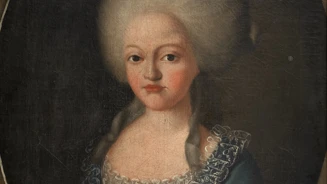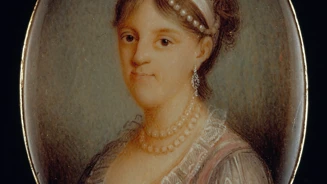Carlota Joaquina: the ‘spoilt’ princess who became the ‘shrew of Queluz’
25 Apr 2025
When we think of a fairytale, we imagine a grand palace – the most luxurious of all – inhabited by a princess who enjoys the finest things in life, wears beautiful gowns, displays the kingdom’s most dazzling jewels, and lives the dream life of every subject. The childhood of Carlota Joaquina at Queluz resembled this image in many ways. But, as we live in the real world, the future Queen of Portugal's life proved far more complex and challenging.
Born on 25 April 1775 at the Royal Palace of Aranjuez in Madrid, Carlota Joaquina de Bourbon was the daughter of Charles IV of Spain and Maria Luisa of Parma. As was customary at the time, marriage negotiations began when she was just three years old. By the age of ten, she had married Infante João, son of Queen Maria I of Portugal.

A childhood of cold hot chocolate and flying sole
Her husband was only eight years her senior, but at that stage in life, the age difference was quite apparent. João himself remarked on it in a letter to his sister, dated September 1785: “She gives the maids more trouble than you did. Every time I see her out in the garden carriage, I miss you terribly, and when I see her going off with a snack, it reminds me of you. She’s very clever and sensible, just very tiny, and I’m very fond of her, but that doesn’t mean I love you any less (…)”
Upon arriving in Portugal, Carlota Joaquina spent much of her time at the Palace of Queluz. Reading the letters of her governess, Miquelina, one might believe her to be a true fairytale princess, with peculiar moods and obstinate whims. “Madam, yesterday and today Her Highness [Carlota] has been very stubborn, refusing to do anything she’s told… This morning, it took her from eight to ten o’clock just to get dressed, put on her corset and drink her chocolate. The more she was urged to hurry, the more she delayed. Infanta Mariana was present during the chocolate, and remarked that in her whole life she had never seen anyone take so long to drink chocolate – she took three-quarters of an hour,” reads a letter sent in 1785 to the Princess of Asturias, Carlota Joaquina’s mother.
That same year, Miquelina recounts two further episodes that show Carlota Joaquina in full form: “I must inform Your Highness that these past days Her Highness has been extremely impertinent and rude in manner, and has performed poorly in her lessons, particularly with Father Felipe… On Saturday, while having lunch with the Infante [João], she picked up a piece of sole and threw it at a maid who was serving the table. Part of it hit the Infante in the face, which he did not appreciate at all, although Her Highness did apologise, saying it wasn’t on purpose (…)”

From Brazil to Portugal, always with political ambition
João – now King João VI – and Carlota Joaquina had nine children, six of whom were born at Queluz, including the future Pedro IV of Portugal (also Pedro I of Brazil) and Miguel, the central figures of the Portuguese Civil War. But Carlota Joaquina was more than a devoted mother – she harboured strong political ambitions and a desire for power. In 1806, she even conspired against her husband, attempting to take on the regency while he was gravely ill. The plot was discovered, and in order to avoid public scandal, the king moved to Mafra, leaving Carlota Joaquina alone at Queluz.
Later, in 1808, João VI succeeded in outmanoeuvring Napoleon Bonaparte: as the French Emperor invaded Portugal, the King transferred the royal court to Brazil, thus preserving the Portuguese crown. Even in Brazil, Carlota Joaquina’s political ambitions endured. She devised a plan to establish a new monarchy in the Spanish-American provinces of the Río de la Plata, positioning herself as regent in the name of her brother, Ferdinand VII. This scheme, too, ended in failure.
With the onset of the Liberal Revolution, Carlota Joaquina became entangled in yet another political crisis. Refusing to swear allegiance to the 1822 Constitution, she was exiled to the Palace of Ramalhão in Sintra. It was there that she helped her favourite son, Miguel, to plan an uprising against the liberals, thus igniting the Civil War. Throughout this period, Carlota Joaquina continued to stir political unrest and champion the Absolutist cause, with the aim of ousting her husband and placing Miguel on the throne. Yet again, her plans failed: they were exposed, Miguel was exiled, and Carlota Joaquina was banished once more to Queluz – this time permanently barred from court. It was during this turbulent chapter that the expression “Shrew of Queluz” emerged, coined by liberals and later popularised by authors such as Camilo Castelo Branco, Oliveira Martins and Raul Brandão.

The heroine of the Absolutists
It was said that, to the Queen’s great sorrow, Miguel ignored her completely upon his return to Portugal and ascension to the throne in 1828. Two years later, whether out of heartbreak or not, she died alone at Queluz. This would make for a poignant fairytale ending, complete with a moral lesson. But the reality is more straightforward: by her final years, Carlota Joaquina was seriously ill and could no longer take an active role in her son’s reign. She remained – by choice or by decree, it is unclear – secluded at Queluz, but not forgotten, as was long believed. Her funeral, held in the palace chapel, honoured her as a heroine of the Absolutist cause: “Her husband, weighed down and beset by a thousand political misfortunes and deceits; her august son, dearly loved, persecuted, exiled and humiliated; the homeland of Afonso and the Portuguese people, submerged and shackled by tireless foreign and domestic foes alike – all found in this Heroic Queen a bulwark, a support, a rallying point to destroy and undo the wicked schemes of deceitful Liberalism… It is only fitting, therefore, Most August King and Lord, that this solemn and mournful tribute be offered to honour her precious and immortal memory.”
Paintings from the collection of the National Palace of Queluz. Photo credits: MMP/ADF
